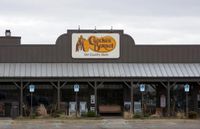Cracker Barrel, the Tennessee-based restaurant chain known for its down-home cooking and country-store charm, is in the midst of its most sweeping transformation in nearly half a century. On August 19, 2025, the company unveiled a new logo and autumn menu, signaling a bold step into the future while aiming to preserve the nostalgia that’s long defined the brand. The changes have sparked a lively debate among customers and industry watchers, with reactions ranging from enthusiastic support to outright outrage.
The most visible change is the new logo—a text-only design that marks the company’s first return to a wordmark since its founding days in 1969. Gone is the iconic image of a man lounging beside a barrel, a symbol that had adorned Cracker Barrel’s signage since 1977. The updated logo retains the familiar gold and brown hues but opts for a sleeker, modern font. According to company representatives, the new design draws inspiration from the original barrel shape and wordmark, blending heritage with a contemporary sensibility.
"People like what we're doing. Cracker Barrel needs to feel like the Cracker Barrel for today and for tomorrow—the things that you love are still there. We need people to choose us, and we want people to choose us," CEO Julie Felss Masino told Good Morning America as the changes rolled out. Her comments reflect the company’s delicate balancing act: updating its image and offerings without alienating the loyal fan base that has kept its doors open for decades.
The logo update is just one component of a massive $700 million transformation plan first announced in May 2024. As reported by The U.S. Sun, the plan aims to modernize Cracker Barrel’s brand and operations in response to stiff competition and shifting consumer tastes. The overhaul encompasses everything from new packaging and signage to a revamped digital presence and refreshed marketing materials. Even the chain’s TV ads are getting a facelift, with country music star Jordan Davis headlining the latest campaign.
Cracker Barrel’s visual refresh extends far beyond the logo. The company is piloting a remodel of its restaurants, trading the dark, rustic interiors and antique-filled nooks for brighter, lighter spaces with a farmhouse flair. Updated lighting, more comfortable seating, and simplified décor are all part of the new look. According to company statements, customer feedback has been largely positive, with many diners asking when their local Cracker Barrel will get the makeover. Still, not everyone is thrilled. Some longtime patrons have taken to social media to voice their displeasure, lamenting the loss of the chain’s “old feel” and threatening to take their business elsewhere.
One Facebook user, quoted by The U.S. Sun, declared, "If it ain't broke, don't fix it." Another scoffed, "What it looks like when you let AI design your logo." The backlash hasn’t been limited to the logo; the broader redesign has also drawn ire. "All they had to do was improve the food to return to what it used to be. No décor change. This type of remodel often spells doom for restaurants. Think of TGIFridays," wrote another user, referencing other chains that have struggled after similar updates.
Despite the controversy, Cracker Barrel’s leadership remains steadfast in its commitment to change. The company currently has 25 to 30 full restaurant remodels underway, with another 25 to 30 partial refreshes expected to be completed by the end of 2025. The goal is clear: to attract new diners and reclaim market share lost to rivals who have outpaced the chain in recent years. "We generally rank in the middle of the peer set," Masino admitted during the May 2024 announcement, noting that Cracker Barrel was lagging in areas such as menu appeal, value, convenience, and overall guest experience. "We’re just not as relevant as we once were."
To address these shortcomings, Cracker Barrel has also been busy innovating its menu. The newly launched autumn offerings include breakfast, lunch, and dinner items designed to appeal to both traditionalists and adventurous eaters. Standouts include the Sausage and Egg Hashbrown Casserole, Butter Pecan French Toast Bake, and Hashbrown Casserole Shepherd’s Pie. For those with a sweet tooth, options like Butter Pecan Sticky Buns and Cinnamon Roll Skillet are now available, alongside drinks such as the Brown Sugar Latte and Wild Berry Tea.
Menu innovation isn’t limited to seasonal fare. In more than 10 locations, the company has tested over 20 new items, including green chili cornbread and banana pudding, according to The U.S. Sun. These efforts are already yielding results: food taste scores have improved by 7%, menu choice scores by 8%, and overall guest experience scores by 7%, as reported by CEO Masino during a recent earnings call. The company’s strategy also involves tweaking prices—lowering them in some locations while raising them in others, based on local market conditions.
Promotional deals have accompanied the rebranding campaign. For example, customers were offered free Classic Sides with any purchase on August 23 and 24, a move designed to entice both loyal regulars and curious newcomers. The company hopes that such gestures, coupled with the new look and menu, will help bridge the gap between tradition and innovation.
Cracker Barrel’s transformation reflects a broader trend in the restaurant and retail industries, where legacy brands are increasingly turning to minimalistic designs and streamlined experiences to stay relevant. Walmart, for instance, updated its logo for the first time in 17 years earlier this year, citing a need to "better represent who Walmart is today." These changes, however, are often met with skepticism from longtime customers who fear that modernization comes at the expense of cherished traditions.
As Cracker Barrel looks ahead to a full rollout of its evolved brand in 2026, the company faces the challenge of winning over both new diners and nostalgic regulars. The stakes are high: success could restore the chain’s standing as a dominant force in American dining, while failure could risk alienating the very customers who made it an institution in the first place.
For now, the debate over Cracker Barrel’s new look and direction continues to simmer, both at the table and online. Whether the gamble pays off remains to be seen, but one thing is certain—after nearly fifty years, Cracker Barrel is betting big on change.





